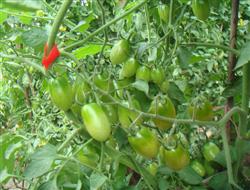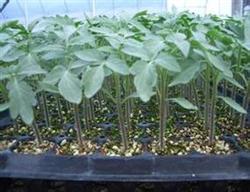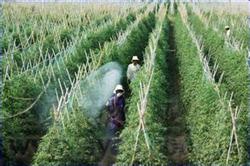Efficient cultivation techniques of Cherry Tomato

Cherry tomato, also known as mini tomato and mini tomato, is a variety of common tomato and eats its berries. The cherry tomato fruit is small, the single fruit weight is 10-20 grams, the plant growth potential is strong, the fruit is many, each plant bears 400-500. The shape of fruit is spherical, jujube-shaped, pear-shaped and so on, which has high ornamental value. The fruit can be eaten raw, cooked, and processed into ketchup, tomato juice and canned tomatoes. Cherry tomato has high nutritional value and is rich in carotene and vitamin C. the sugar content of ripe fruit is as high as 7%, 10%, and the flavor is unique. It also plays an important role in medical and health care, its juice contains calomel, which has the function of diuresis and kidney protection; pericarp hairs can secrete Lutin, which has the same effect as vitamin E, which can reduce blood pressure and prevent cerebral hemorrhage and arteriosclerosis. Cherry tomato is a temperature-loving vegetable. The temperature needed for its growth and development is higher than that of common tomato. The optimum temperature for seed germination, growth and fruiting period is 25-30 ℃, 20-25 ℃ and 15-25 ℃, respectively. Like light, lack of light, serious flower and fruit drop; less water in the early stage, more in the later stage; strong adaptability to soil, the best performance in sandy loam soil, like potash fertilizer, at the same time, in order to prevent the occurrence of navel rot, calcium fertilizer should be applied properly. The yield of cherry tomato is relatively low, with a yield of 6-1500 kg per mu, and the sales price is higher. The main varieties are Virgin, Lingqiu, Cherry Red, Suzuki Taro and so on. The main points of cultivation techniques are as follows: first, cultivation season. The cultivation season of cherry tomato is similar to that of common tomato. For open field cultivation, spring sowing can raise seedlings in the protected field in February, plant after the final frost in late April, and enter the harvest period in the middle and late June. Autumn sowing can raise seedlings in July, plant in August, and start harvesting in October. Cultivation in protected areas can be appropriately early or delayed. Second, sowing and raising seedlings. The cultivation of cherry tomato usually adopts the way of seedling raising and transplanting. ① nursery bed ready. The nursery bed should be selected in the plot where the eggplant vegetables have not been planted, the fertile fields should be mixed with 40% MUE 50% mature organic fertilizer, 1 kg of calcium superphosphate and 5-10 kg of plant ash should be mixed in every cubic meter of nutritious soil, and then sifted and laid on the seedling bed. The seedling bed should be set in the greenhouse in early spring, the electric hotline should be laid if the temperature is too low, and the seedling bed should be set in a cool and ventilated place in summer. There are many Rain Water in summer, the nursery bed should have rain shelter facilities, and the bed end should have drains. ② seed treatment. The diseases of cherry tomato are mostly transmitted by seeds, so seeds should be sterilized before sowing. In order to prevent the occurrence of virus disease, trisodium phosphate is used to disinfect it in production. The method is as follows: first, wet the seeds with clean water, wrap them with gauze, soak them in 10% trisodium phosphate solution for 15-20 minutes, take out the seed bags, wrap them with warm towels and put them at 28 ℃ to accelerate germination. During the period of germination, the seeds were washed once a day, and the seeds could be sown when the seeds were white in about 3-4 days. Sow seeds on ③. The seedling bed is watered first, and the watering can be appropriately smaller when sowing in early spring. In summer, the seeding bed should be fully watered. After the water seeps down, it is evenly sown, and then covered with 1 cm of sifted soil. Seed 3-5 grams per square meter of seedling bed, 6-8 square meters of seedling bed per mu of planting area. ④ seedling management. Heat preservation should be paid attention to in early spring, the ground temperature of seedling bed should be controlled at 25-30 ℃ before emergence, and rain and temperature should be protected in summer. When most of the seeds emerge, the temperature should be cooled in time, and the temperature should be controlled at 20 ℃ during the day and 12-15 ℃ at night. When the seedlings grow 2 true leaves, the seedlings are divided. ⑤ seedlings were divided. The temperature is getting higher and higher in early spring, and the seedling bed generally does not need a floor hotline. Early spring seedling should be carried out in sunny morning, using the method of dark water planting, first open a ditch, and then watering, wait for the water to seep down, release the seedling and bury the soil. After being buried, there is no muddy water on the surface. The row spacing is 10 × 10 cm. Summer seedling separation is carried out in the evening or cloudy days, the method is the same as that in early spring. The row spacing is 10 × 10 cm. Irrigation after planting, sunshade on the border, remove the mulch after slowing down the seedlings. The temperature of seedling separation bed was 25-28 ℃ in daytime and 15-18 ℃ in night before seedling retardation, and 20-25 ℃ in daytime and 13-15 ℃ in night after seedling retardation. It is not watered in early spring, and the seedbed is often watered in summer. The seedlings were planted when they reached 8 true leaves. Third, planting. First, soil preparation, combined with deep ploughing, 5000 kg of rotten organic fertilizer, 20 kg of N, P, K ternary compound fertilizer and 20 kg of superphosphate per mu. After leveling the ground, make a flat bed 150 cm wide (if you buckle plastic film in early spring, you will do 10 cm high, 50-60 cm wide). The flat beds were planted in 3 rows, and the small and high beds were planted in 1 row. The distance between plants is 20-30 cm and 4500-6000 plants per mu. Buckle the plastic film to cover the whole border first, and then set the planting hole according to the plant distance, and the planting depth is 1 cm from the cotyledon to the ground. Fourth, field management. ① watering. If you pour enough planting water, you don't need to water the first inflorescence to blossom and set fruit. If the planting water is less, it can be ditched in the border and carried out in the morning on a sunny day. The first panicle flower was watered with water for the first time after setting fruit, which required a large amount of water in the fruiting period, watering every 5-6 days. Reduce watering during harvest to prevent fruit cracking. ② topdressing. After the first ear flower set fruit, combined with watering, the N, P and K compound fertilizer was applied 10 kg per mu, and when the first ear fruit changed color, 10 kg compound fertilizer per mu was applied to promote fruit development. after that, topdressing was applied once for every 2 ears, and the amount of compound fertilizer was 10 kg per mu. ③ temperature management. The cultivation temperature of protected field is higher than that of common tomato, which is more than 10 ℃ at night, 20-25 ℃ in daytime, and the highest is not more than 35 ℃. ④ pruning. The cherry tomato plant is tall and erect, and it is inserted into a rack when the plant grows to 50 cm to prevent lodging. Lateral branches have strong growth power, generally double-stem pruning, leaving 2 strong branches first, and erasing the others. Generally do not hit the top, when the lower old leaves yellowed off in time to reduce nutrient consumption. ⑤ thinning flowers and protecting fruit. When the temperature is low in early spring, poor pollination is easy to fall flowers, you can use 24-D to smear the newly opened calyx and pedicel (only once). Cherry tomatoes blossom and bear more fruits per panicle. 20-30 fruits with good fruit setting are selected, and the rest are removed. Fifth, harvest. Harvest when fully ripe, and retain sepals and a stalk when harvesting. Sixth, pest prevention and control. Common diseases are early blight, late blight, virus disease, Botrytis cinerea and so on. Control method: rotation with non-Solanaceae crops for 3-4 years. At the initial stage of the disease, 70% mancozeb 500 times solution and 75% chlorothalonil 600 times solution were used, once every 7-10 days, and 4-5 times continuously. Insect pests are mainly aphids, which can be controlled by 2000-3000 times of 20% fenvalerate EC and 2000-3000 times of aphid fog.
- Prev

Management techniques of Cherry Tomato at Seedling stage
When raising seedlings, first do 1.2 meters wide, 10-15 meters long high border seedling bed, the upper soil is broken and leveled, and sifted cow dung and a small amount of phosphate fertilizer mixed evenly, with a stick on the seedling bed every 8-10 cm to press a 1 cm deep shallow ditch, put seeds every 3 cm to 4 cm in the ditch, overlying a layer of sand is about 0.5 cm thick.
- Next

What is the reason for cherry tomato white spot?
Biological characteristics: like temperature, suitable temperature for growth and development is 23 ℃, night temperature is 15 ℃, like plenty of sunlight, soil moisture is 60% 80%, it is suitable for slightly acidic soil with deep, loose and fertile soil layer and 6 Mel 6. 5 PH. Second, variety introduction: Virgin: small fruit variety, by.
Related
- Moge, come on! The staff of the peasant association in the producing area of cantaloupe were frightened when the crowd gathered.
- Causes and Solutions of low Fruit setting rate of Apple
- Symptoms and control measures of passion fruit virus disease
- Fruit growing lesson: how do apple orchards keep high yields?
- Can you build orchards in the mountains? What are the pros and cons?
- How to manage the coloring period of Crisson grape?
- This paper introduces the processing technology of two kinds of fig products.
- How much is a month for retired teachers in rural areas by 2020?
- How can strawberry planting increase sugar content? We should pay attention to management in many aspects.
- What are the cultivation techniques on how to improve the yield of golden fruit?

